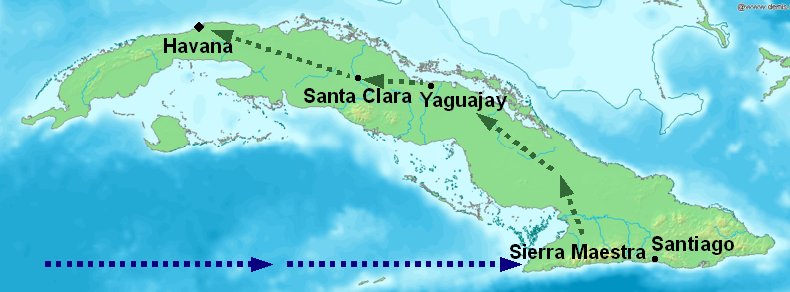Guevara met Fidel Castro and Fidel's brother Raúl in Mexico City where the two were living after having been amnestied from prison in Cuba in 1955. The Castro brothers were preparing to return to Cuba with an expeditionary force in an attempt to overthrow General Fulgencio Batista, who had assumed dictatorial powers following a coup d'état during the 1952 presidential elections. Guevara quickly joined the "26th of July Movement (M-26-7)", named in commemoration of the date of the failed attack on the Moncada barracks that had been the cause of the Castros' imprisonment.
The Castro brothers, Guevara, and approximately 80 other guerrillas departed from Tuxpan, Veracruz, aboard the cabin cruiser Granma in November 1956. Guevara was one of only four non-Cubans aboard. The landing was planned to coincide with an uprising, organized by Frank País, in Santiago de Cuba on 30 November, but Granma was delayed, and the uprising was suppressed. Shortly after disembarking in a swampy area near Niquero in southeastern Cuba on 2 December, the expeditionary unit was attacked by Batista's forces. In the aftermath of the battle of Alegría de Pío where infantry, air and naval attacks killed three rebels, the unit was dispersed into several small groups that lost contact with each other.
Map of Cuba showing the location of the arrival of the rebels on the Granma yacht in late 1956, the rebels' stronghold in the Sierra Maestra, and Guevara's route towards Havana via Las Villas Province in December 1958
Guevara, the troop's physician, writes that during this battle he laid down his knapsack containing medical supplies in order to pick up a box of ammunition dropped by a fleeing comrade, a moment which he later recalled as marking his transition from physician to combatant.[1] Only 15-20 rebels survived these initial engagements to later re-group as a bedraggled fighting force; they then moved deep into the Sierra Maestra mountains where they received support from Frank País's network and local guajiro country folk, including Celia Sánchez Mandulay, Huber Matos, the bandit Cresencio Pérez, and a few covert communists who had been living in those mountains since the 1930s. At their encampments in the distant reaches of the Sierra, they slowly grew in strength, seizing weapons and winning support and recruits from guajiros, montunos and property owners (such as the Babun and Matos) in rural areas and also gaining increasing support from the general population in urban areas. Although the Cuban Communist Party (Partido Socialista Popular) did not back Castro until it was clear he was winning in the middle of 1958, the covert communist cells in the mountains did give assistance. The main source of support, including funding, arms supply and a large contingent of fighters continued to be the non-communist urban branch of the 26th of July Movement, directed by Frank País and, after his death, by "Daniel" (nom de guerre of René Ramos Latour). Guevara did not get along with the Frank País contingent and feuded and criticized them continuously. At El Uvero there were more of Frank País's followers among the combatants than "mountain" guerrillas. Guevara ridiculed these urban fighters for lack of fitness, while he himself was riding a mule because of his asthma.
Guevara gradually gained enough respect and trust from his fellow Sierra fighters for Castro to appoint him commandante of a second army column. In his new role he became something of a "a fanatic of example", a strict disciplinarian whose harsh methods were notorious amongst the rebels.[2] Deserters were severely punished, and on a number of occasions Guevara sent execution squads into the bush to hunt down those he believed were betraying the revolution by seeking an escape. After one such execution, Guevara wrote that he was "not very convinced of the legality of the death, although I used it as an example".[3] On another occasion, Guevara ordered the execution of a deserter whom he was informed had "victimized an entire section of the population, perhaps in collusion with the army". After the man had been shot three times, Guevara wrote; "those who took advantage of the prevailing atmosphere in the area to commit crimes was unfortunately, not infrequent in the Sierra Maestra".[3]
He was selected by Fidel Castro to lead one of the three columns that crossed the plains of the Cauto; it is said that during this westward march he received protection from the escopeteros—men armed with shotguns—of the "Muchachos" de Orlando Lara Batista[4][5] who had already linked up with Camilo Cienfuegos and other main force elements of Fidel Castro's Column 1.[citation needed] Then Guevara crossed, with the support of local Escopeteros the even flatter plains of Camagüey heading towards the mountainous Santa Clara province in central Cuba which his column reached in late 1958.
Saturday, May 12, 2007
Subscribe to:
Post Comments (Atom)


















0 comments:
Post a Comment